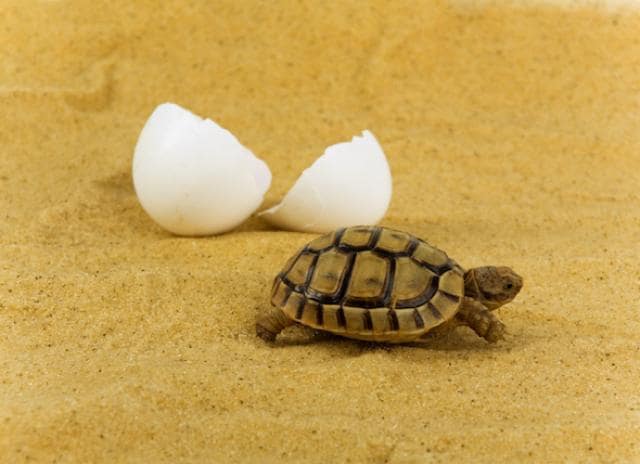Water Turtle Female Pregnant Eggs Eat Her Own Eggs

by Lynne Miller
Turtles and tortoises occupy a special place in the animal kingdom, particularly for their unique mating and reproductive habits. So how, exactly, do turtles have babies? Find out below.
How Do Turtles Mate?
In their book, Turtles and Tortoises: A Complete Pet Owner's Manual, herpetologist Richard Bartlett and biologist Patricia P. Bartlett note that although mating rituals vary by species, red-eared sliders (the most common type of turtle kept as a pet) painted turtles, and other aquatic varieties mate in the water. Mating occurs in the spring, summer, and fall in water that ranges in temperature from 50 to 77 degrees Fahrenheit.
The courtship ritual begins when a male follows a female and they meet face-to-face. The male strokes the female's face and neck with his front claws and, if the female's receptive, she returns the gesture, according to the book's authors. This ritual is repeated a number of times until the female swims to the bottom of the water, signaling to her partner that she's ready to copulate.
Terrestrial turtles and tortoises live and mate on land and their courtship activities can be a bit rougher. According to the book, male turtles can render the female immobile by biting or nipping at her head, neck, limbs, and anterior carapace (the top part of the shell). Copulation may involve shell bumping and the male may nod his head, squeal, or grunt.
In general, turtles lay their first clutch of eggs about three to six weeks after mating. Before they lay their eggs, nearly all turtles prepare by making a nest on land. During the last weeks of gestation, the gravid (pregnant) female spends less time in the water and more time on land, smelling and scratching at the ground in search of the perfect place to lay her eggs. Typically, turtles select a sunny spot with sandy or moist soil to make a nest. If the weather is too warm, however, the turtle may delay digging the nest for days, even weeks, until the weather cools off.
The turtle uses her hind legs to dig a nest and when it is ready she deposits the eggs. Bigger turtles tend to lay bigger eggs and more eggs per clutch. Once the turtle deposits her eggs, her job as a mother is essentially done.
"Most females finish nesting within a couple hours," says Fred Janzen, a professor in the Department of Ecology, Evolution, and Organismal Biology at Iowa State University. "To our knowledge, there seems to be little, if any, parental care involved after this point—unlike, say, in birds and crocodilians."
Females are able to store sperm in their bodies—specifically in the oviduct, or Fallopian tube—which can be used for up to three clutches of eggs and can remain viable for up to three years. Many turtles and tortoises lay more than a single clutch of eggs each year and, interestingly, a single clutch of eggs can have multiple fathers.
For most turtles, incubation ranges from 45 to 75 days, depending on the temperature inside the egg. Warmer temperatures speed up development and cooler temperatures slow it down. A new hatchling breaks open its egg with its egg tooth, which falls out about an hour after hatching and never grows back.
After hatching, a newborn turtle uncurls its body and shell. When it leaves the eggshell, the baby turtle will have a small yolk sac protruding from its plastron (the underside of the shell). It is similar in form and function to the mammalian placenta that remains attached at birth with humans and other mammals, and is found right about where one would expect to find a "belly-button." The yolk sac is left intact so that it can be absorbed into the newborn's body, providing nourishment in the early days of the baby's life.
Breeding Turtles in Captivity
It is very important to note that female reptiles in captivity can lay eggs even without a male present (these eggs are non-fertile). This can lead to major health issues for the female turtle, such as impacted eggs or eggs that rupture internally. Symptoms of these conditions include a loss of appetite, lack of energy, bulging eyes, and poor swimming. Additionally, producing eggs (whether viable or not) can lead to a calcium deficiency in your female turtle, so make sure she has a good diet, good UV lighting, and good vitamin and mineral supplements.
Unlike what happens in the wild, breeding turtles in captivity can require human intervention. Breeding, hatching, and raising tortoises and turtles is a hobby for some reptile hobbyists. Enthusiasts also work with conservation groups to breed turtles that are considered endangered, typically not the common turtles sold in pet stores. Breeding turtles and tortoises should be left to expert herpetologists, as they understand the legal, medical, and husbandry issues related to the species in question.
Image: -V- / Shutterstock
Water Turtle Female Pregnant Eggs Eat Her Own Eggs
Source: https://www.petmd.com/reptile/care/evr_rp_how-do-turtles-have-babies